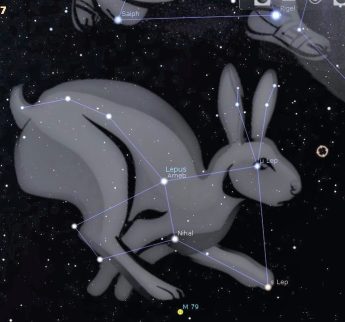This Week’s Sky at a Glance, 2024 March 30 – April 6
This Week’s Sky at a Glance, 2024 March 30 – April 6
With Easter happening this weekend let us look for signs of it in the night sky. Lambs have long been associated with spring and Easter, so we can start with Aries the Ram low in the west. For many, the symbol of Easter is Peter Cottontail, the Easter Bunny. When darkness sets in we can see Lepus the Hare below the feet of Orion. I see the constellation as three vertical pairs of stars, with the brightest pair in the middle and the widest to the right. With a reasonably dark sky you can see the bunny ears between the widest pair and Orion’s brightest star, Rigel.
In Germanic mythology Ostara, the goddess of spring, found a wounded bird and changed it into a hare so that it could survive. This animal was allowed to run as fast as it could fly and it retained the ability to lay eggs, which it did in spring to honour its rescuer. The Saxon name for the goddess was Eostre.
Sunrise services are a popular way to celebrate Easter, and that is a good time to look for religious Easter symbols in the sky if you are an hour or two early. The Northern Cross, the most recognizable part of Cygnus the Swan, is on its side high in the east among the procession of constellations. Look for semicircular Corona Borealis high in the south, one third of the way from the bright star Arcturus toward equally bright Vega. Can you picture this as a cave with an open door?
I think the best symbol is seen on the Moon when it is full or nearly so. When it rises in spring, look for the dark bunny ears to the upper right. With them identified, it isn’t difficult to picture Peter Cottontail clutching a giant egg.
This Week in the Solar System
Saturday’s sunrise is at 7:07 and sunset will occur at 7:50, giving 12 hours, 43 minutes of daylight. Next Saturday the Sun will rise at 6:54 and set at 7:59, giving 13 hours, 5 minutes of daylight.
The Moon is at third quarter on Tuesday, heading toward a meet-up with Mars and Saturn next weekend. This weekend Mercury sets 90 minutes after sunset, but that gap will close to 45 minutes by the end of the week. With the lengthening daylight Jupiter is appearing lower in the west and past prime observing, heading toward conjunction in mid-May. Rising around 6 am midweek, Mars is moving toward a conjunction with Saturn in the following week. Venus is getting too close to the Sun for comfortable viewing as it crawls toward superior conjunction in early June. The subtle wedge of zodiacal light might be see in rural areas about 90 minutes after sunset, and on Monday comet 12P/Pons-Brooks might be seen within a binocular view of Hamal, the brightest star in Aries.
On Sunday evening at 8 pm, tune in to the Sunday Night Astronomy Show via the Facebook page or YouTube channel of Astronomy by the Bay.

